TOYOTA MIRAI 2017 1.G Owners Manual
Manufacturer: TOYOTA, Model Year: 2017, Model line: MIRAI, Model: TOYOTA MIRAI 2017 1.GPages: 464, PDF Size: 12.09 MB
Page 401 of 464
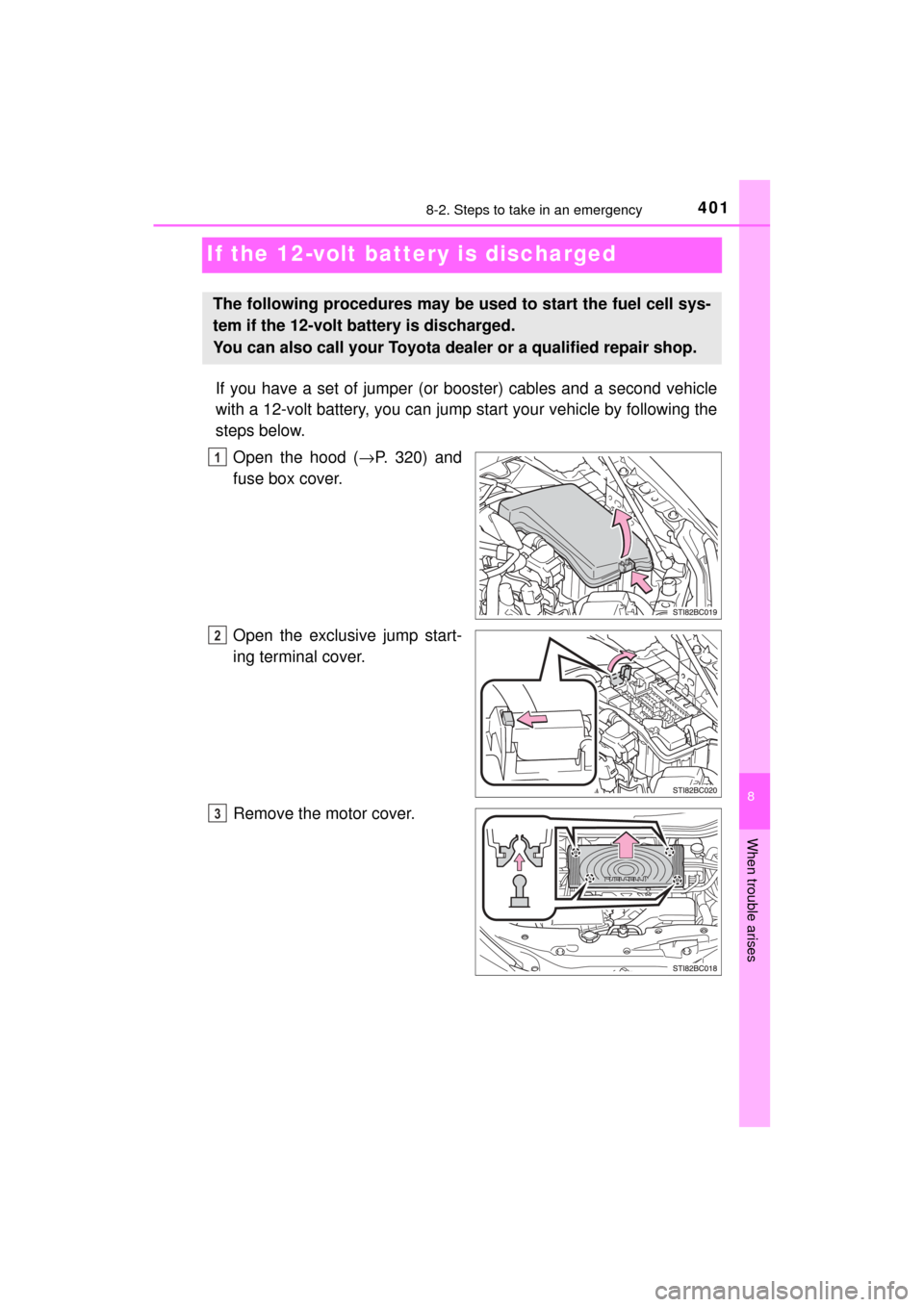
4018-2. Steps to take in an emergency
MIRAI_OM_USA_OM62023U
8
When trouble arises
If the 12-volt battery is discharged
If you have a set of jumper (or booster) cables and a second vehicle
with a 12-volt battery, you can jump start your vehicle by following the
steps below.
Open the hood ( →P. 320) and
fuse box cover.
Open the exclusive jump start-
ing terminal cover.
Remove the motor cover.
The following procedures may be used to start the fuel cell sys-
tem if the 12-volt battery is discharged.
You can also call your Toyota de aler or a qualified repair shop.
1
2
3
Page 402 of 464
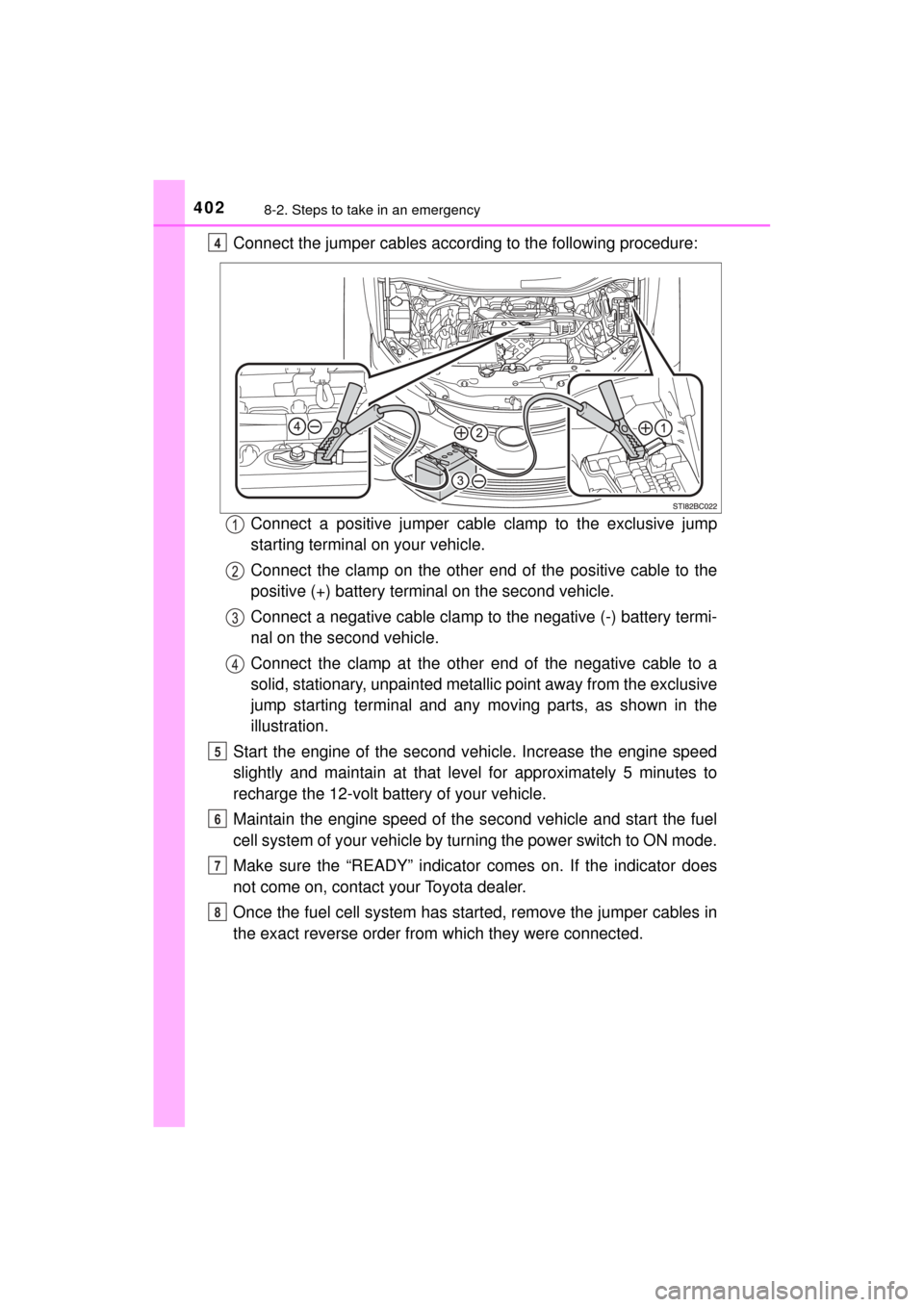
4028-2. Steps to take in an emergency
MIRAI_OM_USA_OM62023U
Connect the jumper cables according to the following procedure:Connect a positive jumper cabl e clamp to the exclusive jump
starting terminal on your vehicle.
Connect the clamp on the other e nd of the positive cable to the
positive (+) battery terminal on the second vehicle.
Connect a negative cable clamp to the negative (-) battery termi-
nal on the second vehicle.
Connect the clamp at the other end of the negative cable to a
solid, stationary, unpainted metallic point away from the exclusive
jump starting terminal and any moving parts, as shown in the
illustration.
Start the engine of the second v ehicle. Increase the engine speed
slightly and maintain at that level for approximately 5 minutes to
recharge the 12-volt battery of your vehicle.
Maintain the engine speed of the second vehicle and start the fuel
cell system of your vehicle by turn ing the power switch to ON mode.
Make sure the “READY” indicato r comes on. If the indicator does
not come on, contact your Toyota dealer.
Once the fuel cell system has started, remove the jumper cables in
the exact reverse order from which they were connected.4
5
6
7
8
Page 403 of 464
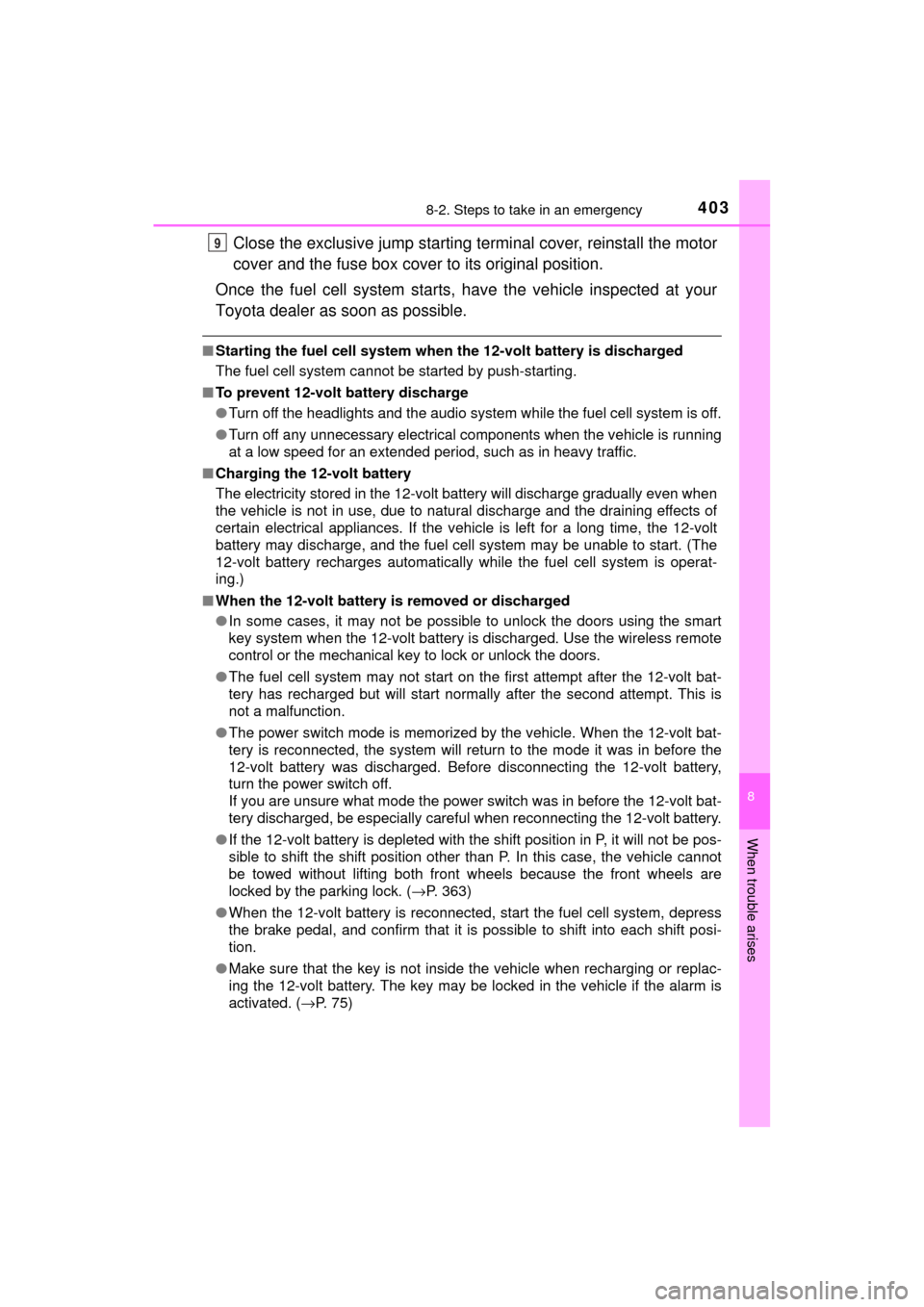
4038-2. Steps to take in an emergency
MIRAI_OM_USA_OM62023U
8
When trouble arises
Close the exclusive jump starting terminal cover, reinstall the motor
cover and the fuse box cover to its original position.
Once the fuel cell system starts, have the vehicle inspected at your
Toyota dealer as soon as possible.
■ Starting the fuel cell system when the 12-volt battery is discharged
The fuel cell system cannot be started by push-starting.
■ To prevent 12-volt battery discharge
●Turn off the headlights and the audio system while the fuel cell system is off.
● Turn off any unnecessary electrical components when the vehicle is running
at a low speed for an extended period, such as in heavy traffic.
■ Charging the 12-volt battery
The electricity stored in the 12-volt battery will discharge gradually even when
the vehicle is not in use, due to natural discharge and the draining effects of
certain electrical appliances. If the vehicle is left for a long time, the 12-volt
battery may discharge, and the fuel cell system may be unable to start. \
(The
12-volt battery recharges automatically while the fuel cell system is operat-
ing.)
■ When the 12-volt battery is removed or discharged
●In some cases, it may not be possible to unlock the doors using the smart
key system when the 12-volt battery is discharged. Use the wireless remote
control or the mechanical key to lock or unlock the doors.
● The fuel cell system may not start on the first attempt after the 12-volt bat-
tery has recharged but will start normally after the second attempt. This is
not a malfunction.
● The power switch mode is memorized by the vehicle. When the 12-volt bat-
tery is reconnected, the system will return to the mode it was in before the
12-volt battery was discharged. Before disconnecting the 12-volt battery,
turn the power switch off.
If you are unsure what mode the power switch was in before the 12-volt bat-
tery discharged, be especially careful when reconnecting the 12-volt battery.
● If the 12-volt battery is depleted with the shift position in P, it will not be pos-
sible to shift the shift position other than P. In this case, the vehicle cannot
be towed without lifting both front wheels because the front wheels are
locked by the parking lock. ( →P. 363)
● When the 12-volt battery is reconnected, start the fuel cell system, depress
the brake pedal, and confirm that it is possible to shift into each shift posi-
tion.
● Make sure that the key is not inside the vehicle when recharging or replac-
ing the 12-volt battery. The key may be locked in the vehicle if the alarm is
activated. ( →P. 75)
9
Page 404 of 464
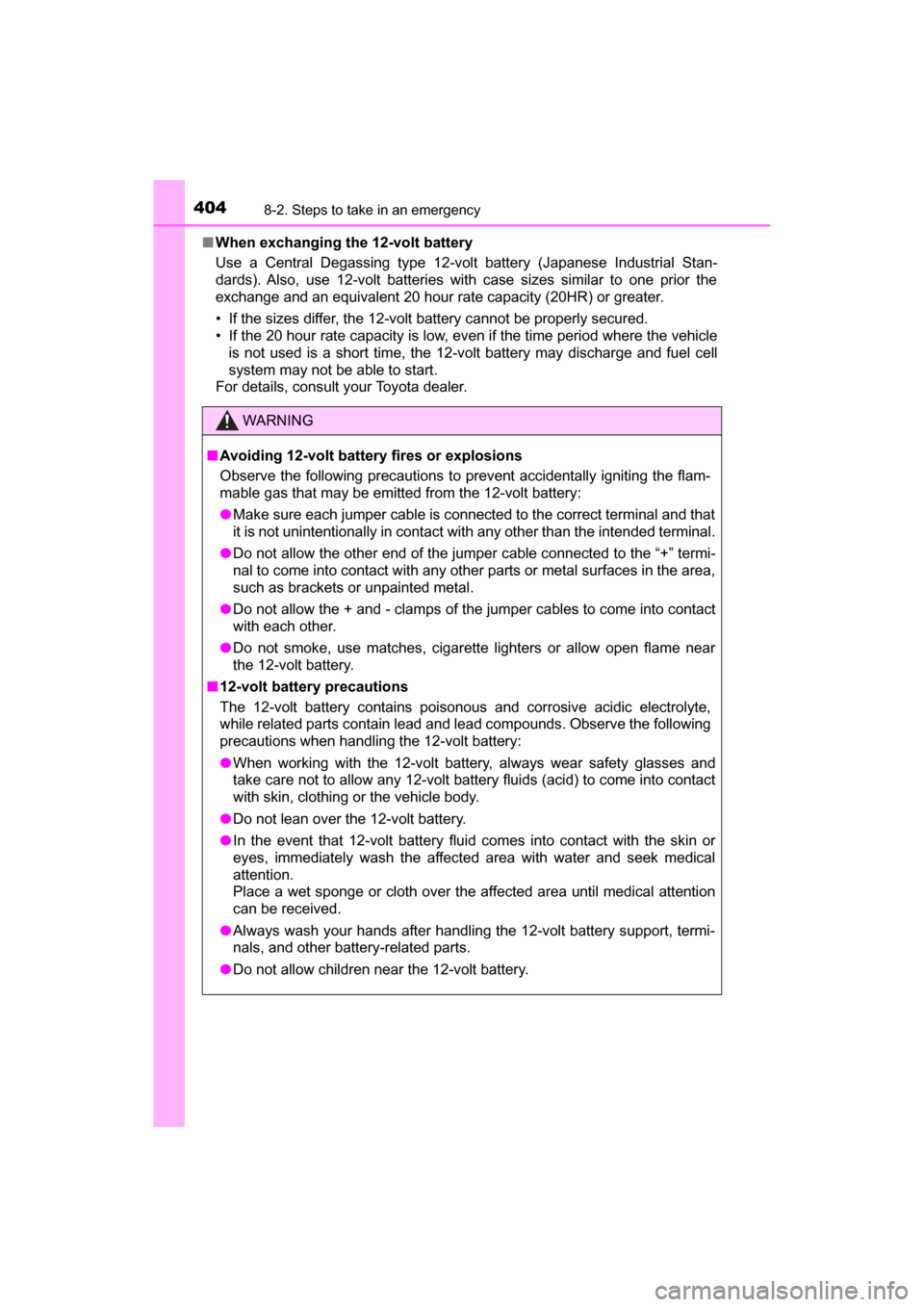
4048-2. Steps to take in an emergency
MIRAI_OM_USA_OM62023U■
When exchanging the 12-volt battery
Use a Central Degassing type 12-volt battery (Japanese Industrial Stan-
dards). Also, use 12-volt batteries with case sizes similar to one prior the
exchange and an equivalent 20 hour rate capacity (20HR) or greater.
• If the sizes differ, the 12-volt battery cannot be properly secured.
• If the 20 hour rate capacity is low, even if the time period where the vehicle
is not used is a short time, the 12-volt battery may discharge and fuel cell
system may not be able to start.
For details, consult your Toyota dealer.
WARNING
■ Avoiding 12-volt battery fires or explosions
Observe the following precautions to prevent accidentally igniting the flam-
mable gas that may be emitted from the 12-volt battery:
● Make sure each jumper cable is connected to the correct terminal and that
it is not unintentionally in contact with any other than the intended terminal.
● Do not allow the other end of the jumper cable connected to the “+” termi-
nal to come into contact with any other parts or metal surfaces in the area,
such as brackets or unpainted metal.
● Do not allow the + and - clamps of the jumper cables to come into contact
with each other.
● Do not smoke, use matches, cigarette lighters or allow open flame near
the 12-volt battery.
■ 12-volt battery precautions
The 12-volt battery contains poisonous and corrosive acidic electrolyte,
while related parts contain lead and lead compounds. Observe the following
precautions when handling the 12-volt battery:
● When working with the 12-volt battery, always wear safety glasses and
take care not to allow any 12-volt battery fluids (acid) to come into contact
with skin, clothing or the vehicle body.
● Do not lean over the 12-volt battery.
● In the event that 12-volt battery fluid comes into contact with the skin or
eyes, immediately wash the affected area with water and seek medical
attention.
Place a wet sponge or cloth over the affected area until medical attention
can be received.
● Always wash your hands after handling the 12-volt battery support, termi-
nals, and other battery-related parts.
● Do not allow children near the 12-volt battery.
Page 405 of 464
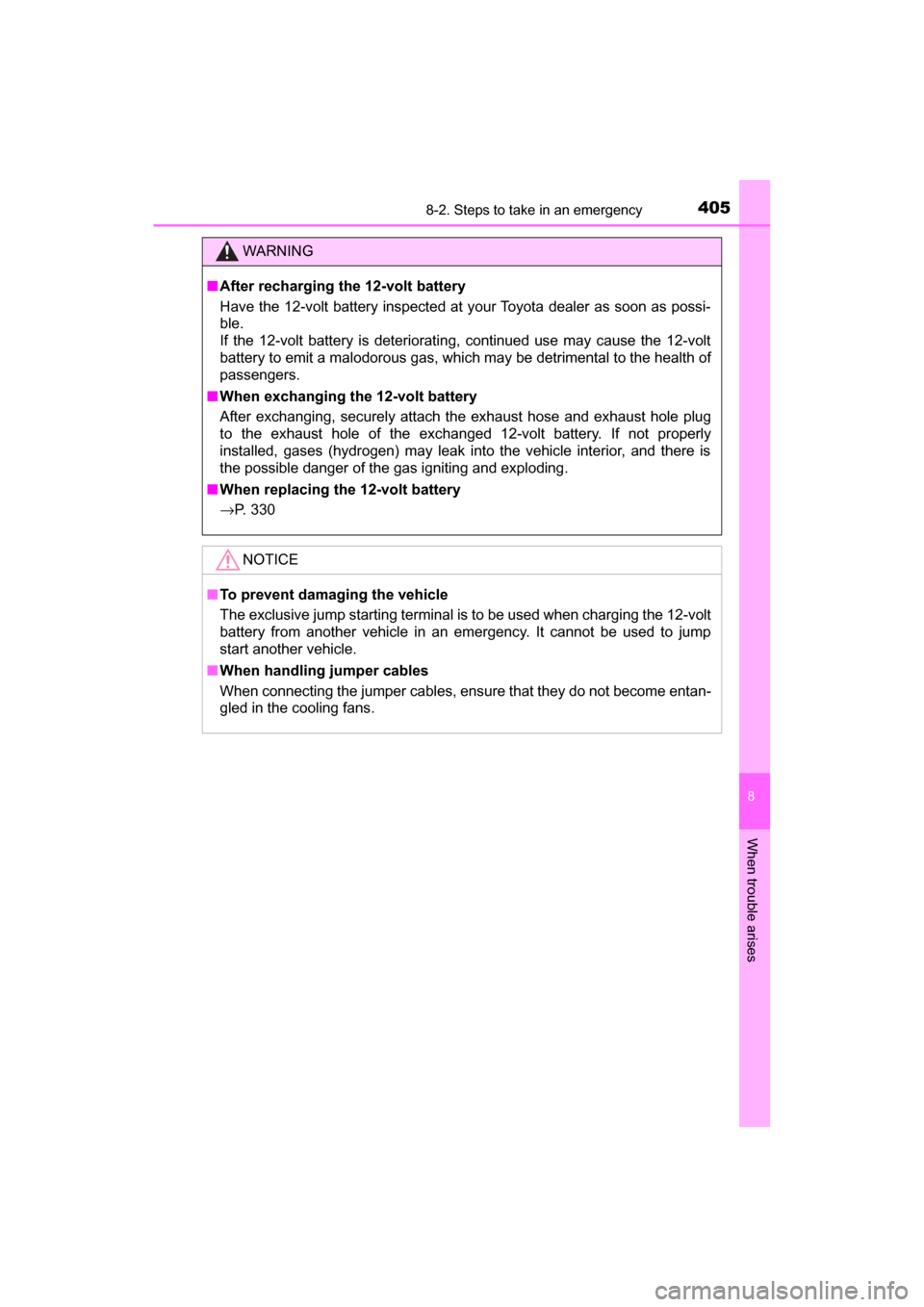
4058-2. Steps to take in an emergency
MIRAI_OM_USA_OM62023U
8
When trouble arises
WARNING
■After recharging the 12-volt battery
Have the 12-volt battery inspected at your Toyota dealer as soon as possi-
ble.
If the 12-volt battery is deteriorating, continued use may cause the 12-volt
battery to emit a malodorous gas, which may be detrimental to the health of
passengers.
■ When exchanging the 12-volt battery
After exchanging, securely attach the exhaust hose and exhaust hole plug
to the exhaust hole of the exchanged 12-volt battery. If not properly
installed, gases (hydrogen) may leak into the vehicle interior, and there is
the possible danger of the gas igniting and exploding.
■ When replacing the 12-volt battery
→ P. 330
NOTICE
■ To prevent damaging the vehicle
The exclusive jump starting terminal is to be used when charging the 12-volt
battery from another vehicle in an emergency. It cannot be used to jump
start another vehicle.
■ When handling jumper cables
When connecting the jumper cables, ensure that they do not become entan-
gled in the cooling fans.
Page 406 of 464
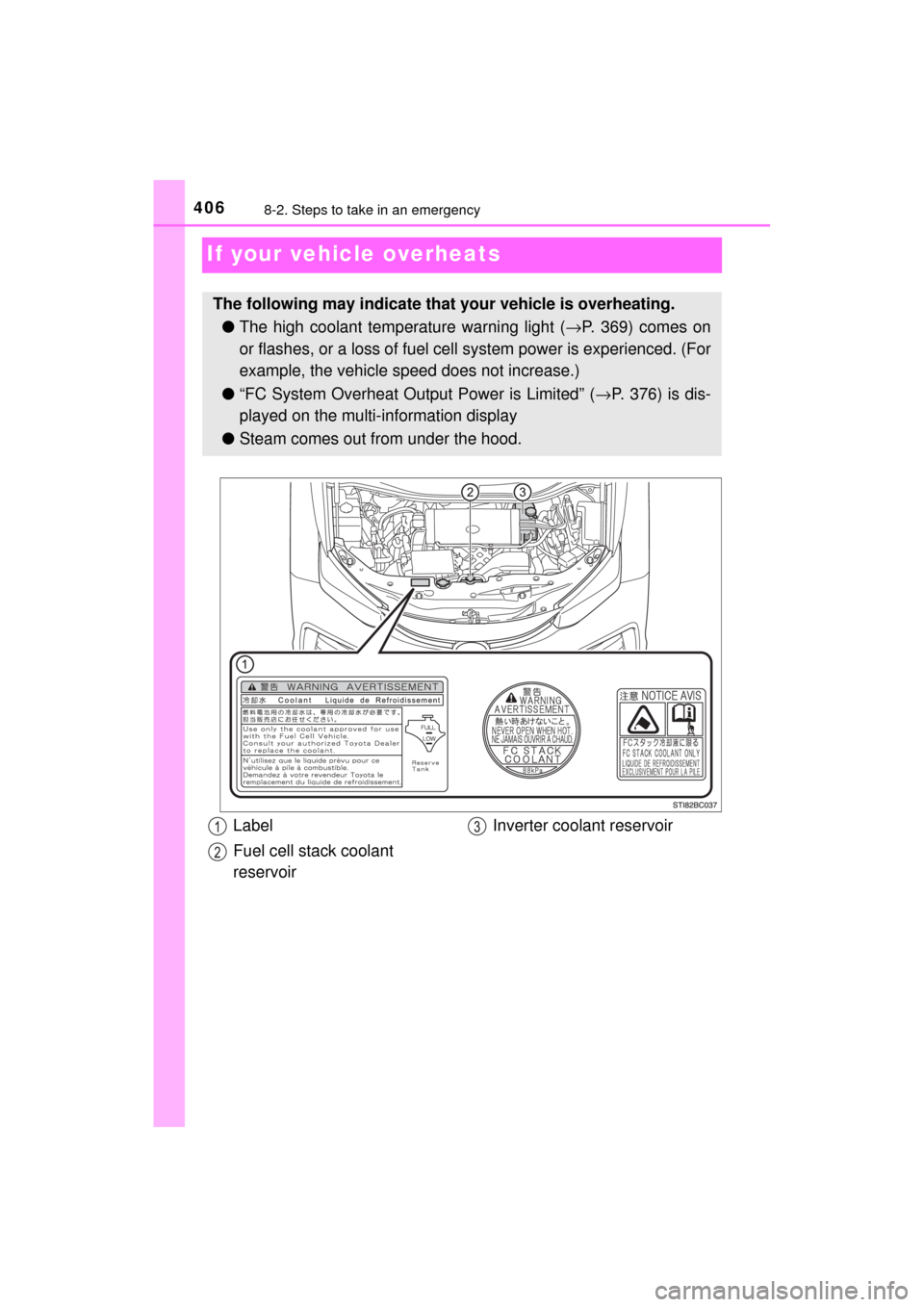
4068-2. Steps to take in an emergency
MIRAI_OM_USA_OM62023U
If your vehicle overheats
The following may indicate that your vehicle is overheating.
● The high coolant temperature warning light ( →P. 369) comes on
or flashes, or a loss of fuel ce ll system power is experienced. (For
example, the vehicle s peed does not increase.)
● “FC System Overheat Out put Power is Limited” (→P. 376) is dis-
played on the multi- information display
● Steam comes out from under the hood.
Label
Fuel cell stack coolant
reservoir Inverter coolant reservoir
Page 407 of 464
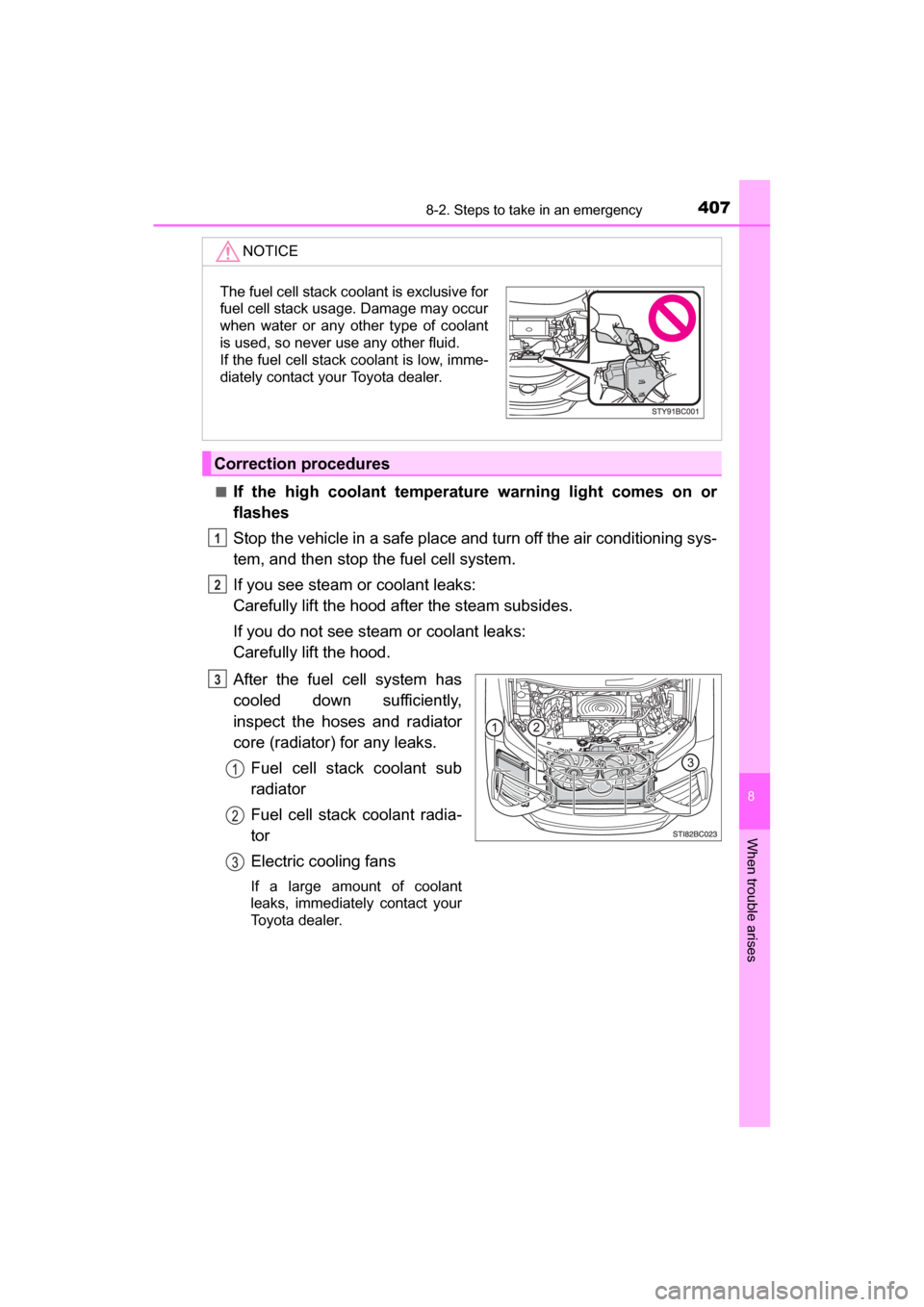
4078-2. Steps to take in an emergency
MIRAI_OM_USA_OM62023U
8
When trouble arises
■If the high coolant temperature warning light comes on or
flashes
Stop the vehicle in a safe place and turn off the air conditioning sys-
tem, and then stop the fuel cell system.
If you see steam or coolant leaks:
Carefully lift the hood after the steam subsides.
If you do not see steam or coolant leaks:
Carefully lift the hood.
After the fuel cell system has
cooled down sufficiently,
inspect the hoses and radiator
core (radiator) for any leaks.
Fuel cell stack coolant sub
radiator
Fuel cell stack coolant radia-
tor
Electric cooling fans
If a large amount of coolant
leaks, immediately contact your
Toyota dealer.
NOTICE
Correction procedures
The fuel cell stack coolant is exclusive for
fuel cell stack usage. Damage may occur
when water or any other type of coolant
is used, so never use any other fluid.
If the fuel cell stack coolant is low, imme-
diately contact your Toyota dealer.
1
2
3
Page 408 of 464
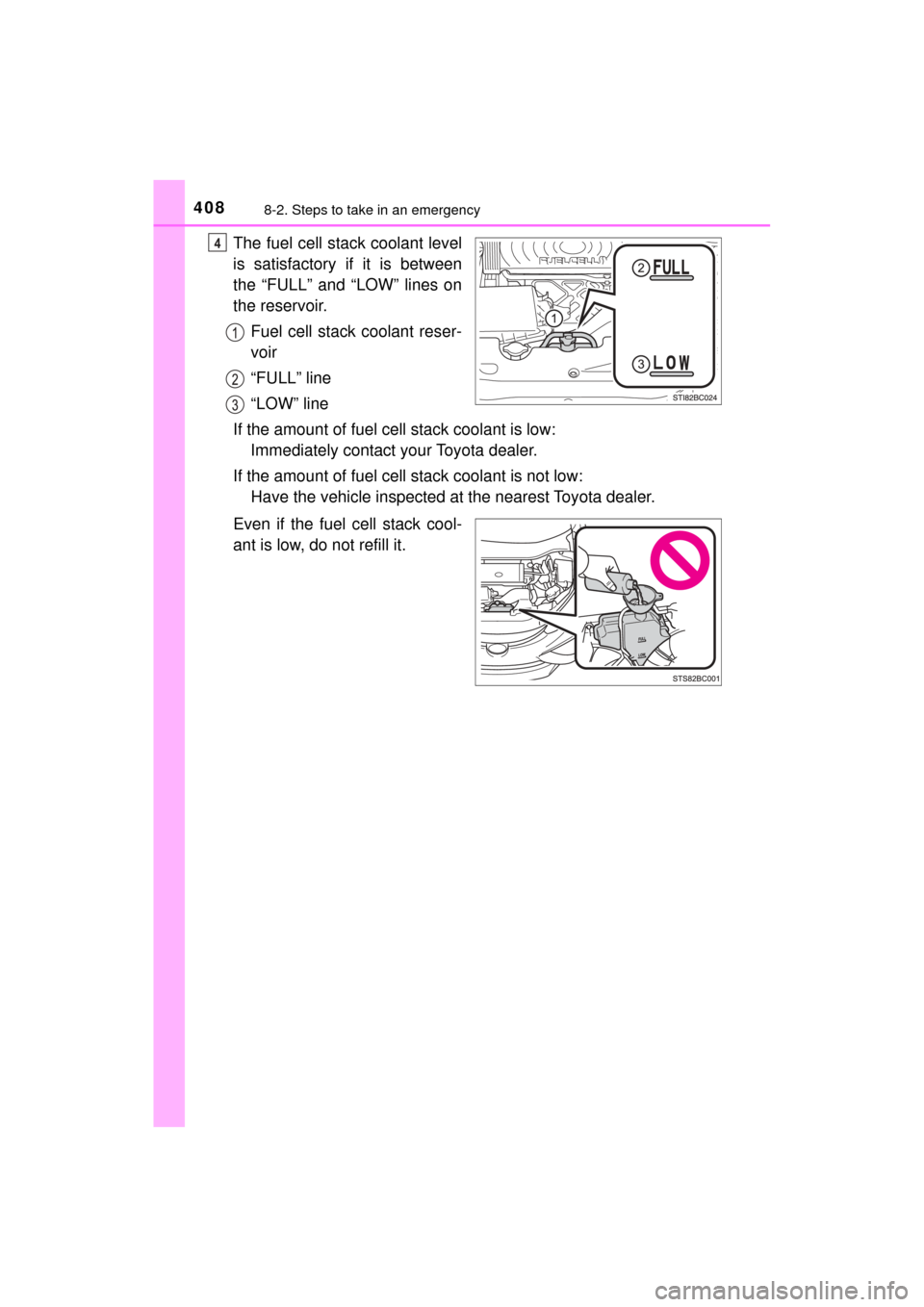
4088-2. Steps to take in an emergency
MIRAI_OM_USA_OM62023U
The fuel cell stack coolant level
is satisfactory if it is between
the “FULL” and “LOW” lines on
the reservoir.
Fuel cell stack coolant reser-
voir
“FULL” line
“LOW” line
If the amount of fuel cell stack coolant is low: Immediately contact your Toyota dealer.
If the amount of fuel cell stack coolant is not low: Have the vehicle inspected at the nearest Toyota dealer.
Even if the fuel cell stack cool-
ant is low, do not refill it.4
Page 409 of 464
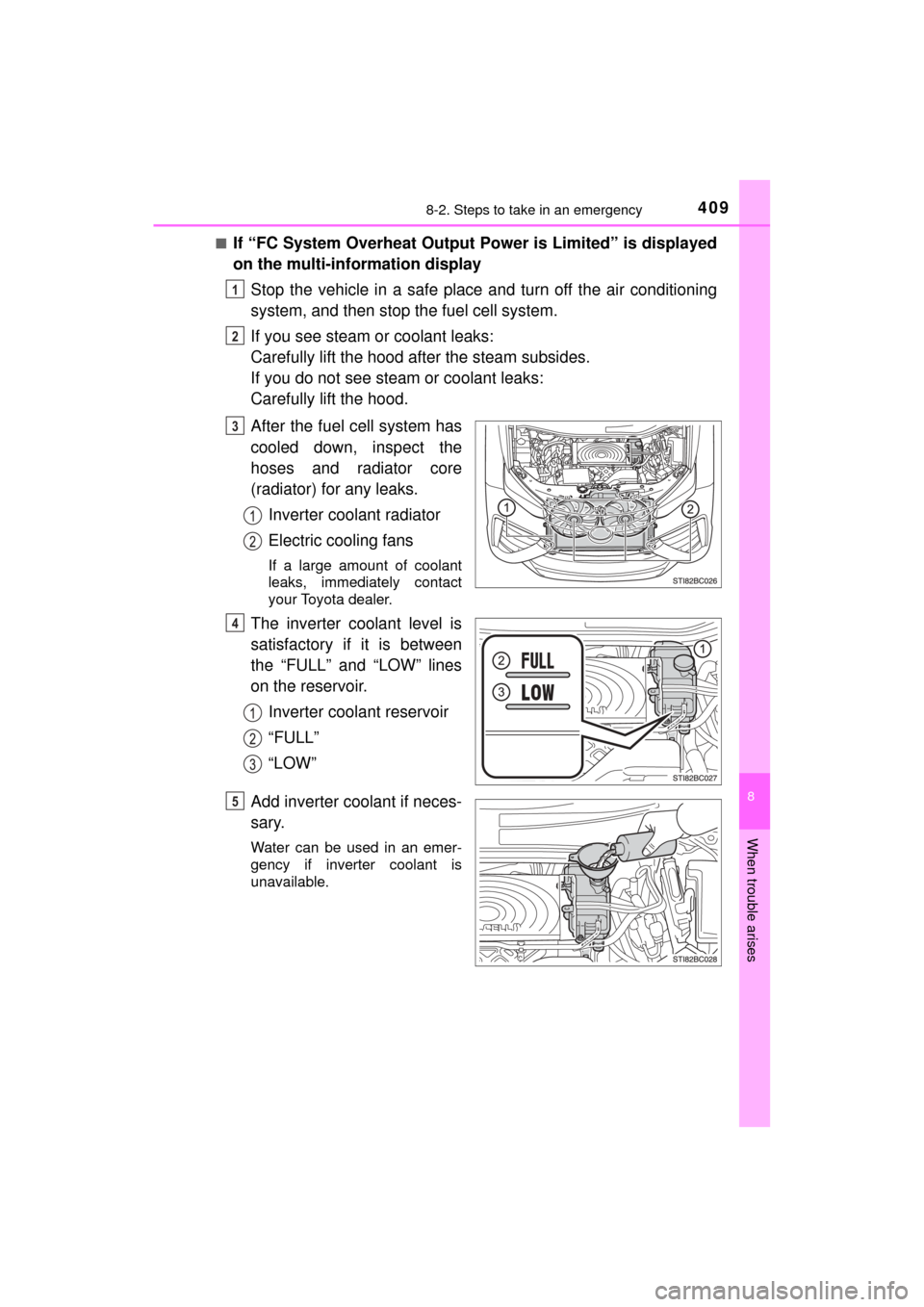
4098-2. Steps to take in an emergency
MIRAI_OM_USA_OM62023U
8
When trouble arises
■If “FC System Overheat Output Power is Limited” is displayed
on the multi-information displayStop the vehicle in a safe place and turn off the air conditioning
system, and then stop the fuel cell system.
If you see steam or coolant leaks:
Carefully lift the hood after the steam subsides.
If you do not see steam or coolant leaks:
Carefully lift the hood.
After the fuel cell system has
cooled down, inspect the
hoses and radiator core
(radiator) for any leaks.
Inverter coolant radiator
Electric cooling fans
If a large amount of coolant
leaks, immediately contact
your Toyota dealer.
The inverter coolant level is
satisfactory if it is between
the “FULL” and “LOW” lines
on the reservoir.Inverter coolant reservoir
“FULL”
“LOW”
Add inverter coolant if neces-
sary.
Water can be used in an emer-
gency if inverter coolant is
unavailable.
1
2
3
4
5
Page 410 of 464
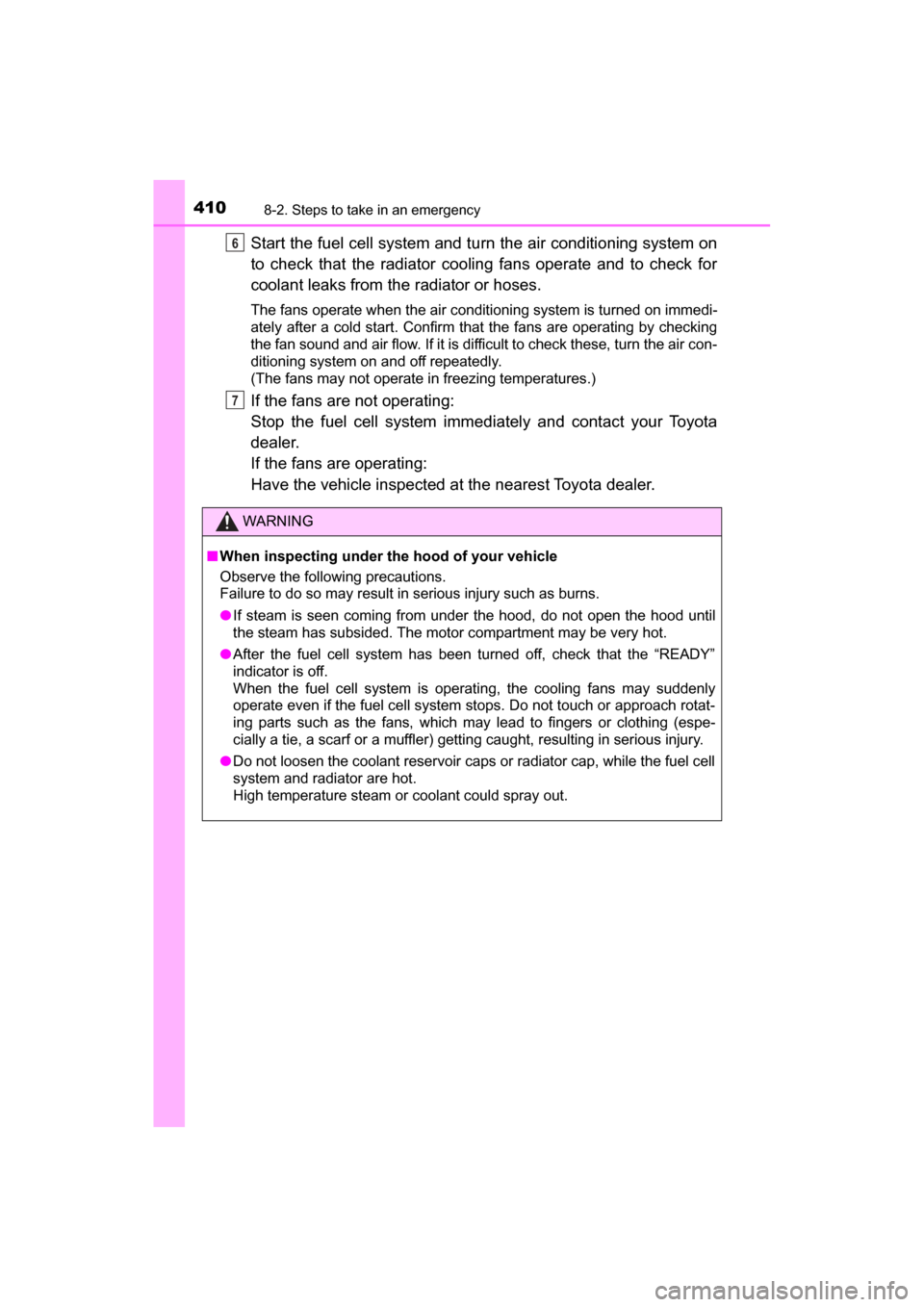
4108-2. Steps to take in an emergency
MIRAI_OM_USA_OM62023U
Start the fuel cell system and turn the air conditioning system on
to check that the radiator cooling fans operate and to check for
coolant leaks from th e radiator or hoses.
The fans operate when the air conditioning system is turned on immedi-
ately after a cold start. Confirm that the fans are operating by checking
the fan sound and air flow. If it is difficult to check these, turn the air con-
ditioning system on and off repeatedly.
(The fans may not operate in freezing temperatures.)
If the fans are not operating:
Stop the fuel cell system immedi ately and contact your Toyota
dealer.
If the fans are operating:
Have the vehicle inspected at the nearest Toyota dealer.
WARNING
■ When inspecting under the hood of your vehicle
Observe the following precautions.
Failure to do so may result in serious injury such as burns.
● If steam is seen coming from under the hood, do not open the hood until
the steam has subsided. The motor compartment may be very hot.
● After the fuel cell system has been turned off, check that the “READY”
indicator is off.
When the fuel cell system is operating, the cooling fans may suddenly
operate even if the fuel cell system stops. Do not touch or approach rotat-
ing parts such as the fans, which may lead to fingers or clothing (espe-
cially a tie, a scarf or a muffler) getting caught, resulting in serious injury.
● Do not loosen the coolant reservoir caps or radiator cap, while the fuel cell
system and radiator are hot.
High temperature steam or coolant could spray out.
6
7